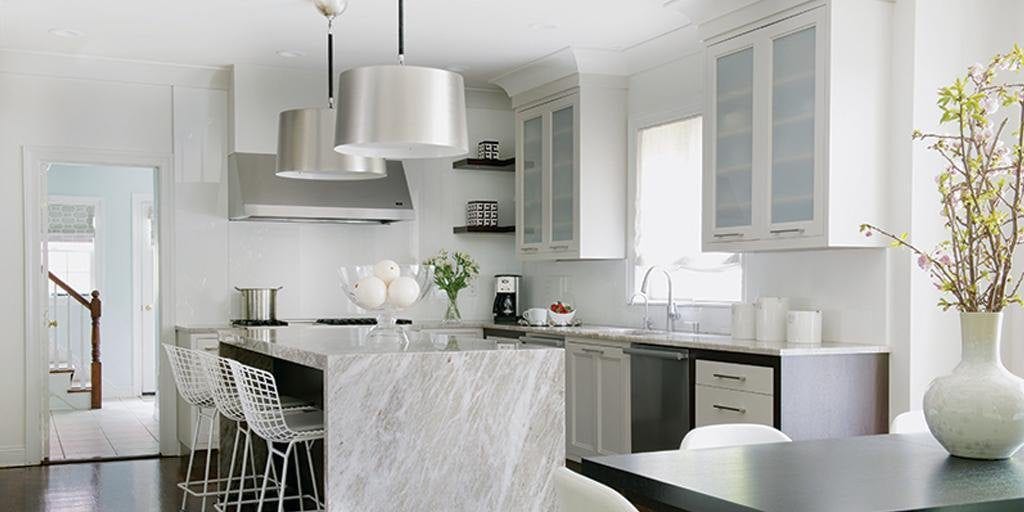If the bright and beautiful days of July stand in stark contrast to your home’s dark and drab interior, read on …
By Tammy Adamson-McMullen
July is a bright and beautiful month! The sun is shining, the flowers are in bloom, fruit and vegetables are flourishing, and the sky is a lovely shade of blue. Most of us look forward to being outside this time of year; but if you dread going back inside—really dread it—it may mean that your interior needs some brightening and beautifying as well.
Here are some relatively easy and inexpensive ways to make your home’s inside match the outside.
Add White—One of the best ways to brighten a dark space is to add white as an accent. Add white pillows to sofas and chairs, white towels in the bathroom, white linens at the table, a white area rug—or at least one with a light background—onto a dark floor, and so on. White is a terrific brightener but isn’t an absolute requirement; you can achieve a brightening effect by adding accents in other light colors, too. Just make sure that the accent colors work with your current palette.
Lighten Paint Colors—One of the best ways to brighten your spaces is with paint. Start with your trim. If your trim is a dark paint color or wood tone, paint it white or another light color that works with your color scheme. If rooms still feel dark, then paint the walls and ceilings in a lighter color, too. This is the best way to lighten a home’s interior, says interior designer Natalie Collins Shaw of Kitsap Kitchen & Bath Co. in Kitsap County, Wash., where the rainy weather creates a demand for brighter interiors.
“When I’m working with clients who have particularly dark and dismal spaces, I usually first recommend lightening up the wall color,” Collins Shaw says. “Painting is a cost-effective way to make a huge impact on the feel of a space.” For light colors, Collins Shaw recommends classic warm gray, beiges, white with a tint of gray and similar neutrals. Additionally, “By keeping the walls subtle, there is essentially a blank canvas to change up your décor for the different seasons,” she adds.
Un-layer—Window treatments can be the main obstacle in keeping your home from looking its brightest. If your windows have multiple layers, consider taking one or two of the layers down during summer months. You may not need heavy draperies on top of sheers, for example, or sheers on top of shades. If your undertreatments need updating, now might be a good time to invest in some of the stylish light-control options on the market, such as top-down/bottom-up shades, honeycomb shades, wood blinds, or shutters with adjustable slats. To keep windows looking their brightest, choose treatments in light or neutral hues.
Add Light—Once you’ve increased the ambient light, then it’s time to increase your home’s artificial light, too. Many design experts recommend that you begin by adding task lighting first (for those places where you accomplish day-to-day tasks) and accent lighting as needed (for darkened corners and shadowy areas). Task lighting is the most important but often the most lacking, especially in kitchens, says Collins Shaw. Her “go-to” solution is to add LED undercabinet lighting. “And I always put them on a dimmer switch,” she says, “which gives you options for mood lighting.”
LED strips also can be used for accent lighting, tucked above crown molding; within alcoves, niches, recesses and other architectural features; around headboards and under bed frames; and in so many other places. To create a lot of brightness, Collins Shaw recommends adding glass panels in upper cabinets. Then, “Go ahead and insert some LED lighting inside with glass shelving to really make a statement!” she says.
Enhance Reflection—Glass surfaces in general can help to brighten your home. Glass can make your home feel more open while also helping to disperse light. If you’re in the market for new furnishings, consider pieces that are at least partially made of glass, such as glass-top dining or occasional tables. Light fixtures with glass bases or sconces also are ideal for this purpose, suggests Collins Shaw. “By either adding or updating current fixtures with clear glass and daylight LED bulbs, one can truly lighten up the feel and look of a space to get that refreshing airiness most of us are after,” she says.
Of course, one of the best ways to enhance your ambient and artificial light source is with mirrors, but be sure to place them correctly. Place large mirrors across from windows to reflect ambient light and bounce it throughout the room, and small mirrors next to artificial light sources, such as table lamps. For optimum light reflection, hang large mirrors straight on the wall, rather than angled on a stand.
Consider Metallic Finishes—You also can brighten dark areas with reflective coating and wallcovering finishes. Pearlescent and metallic finishes work beautifully to lighten areas that typically are difficult to brighten, such as above and below top cabinetry (soffits and backsplashes), and they look stunning, too. When choosing metallic finishes, opt for light colors—a polished chrome rather than burnished pewter, for example—to make your space the brightest it can be.

 Interior Paints
Interior Paints Exterior Paints
Exterior Paints Primers
Primers Stains & Clears
Stains & Clears
 Paint Brushes
Paint Brushes Paint Roller
Paint Roller Paint Trays & Liners
Paint Trays & Liners
